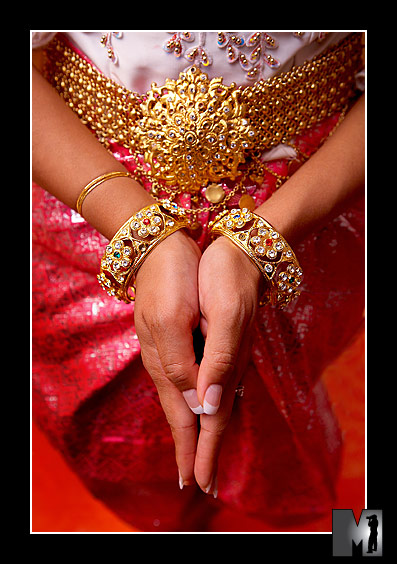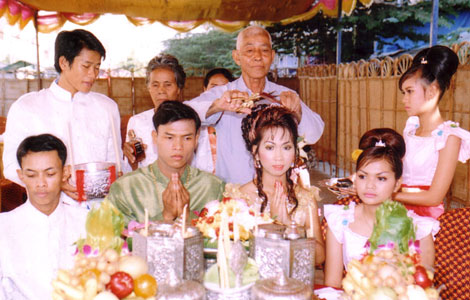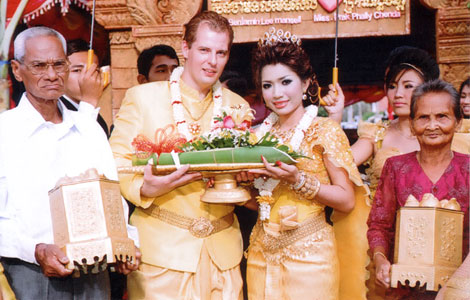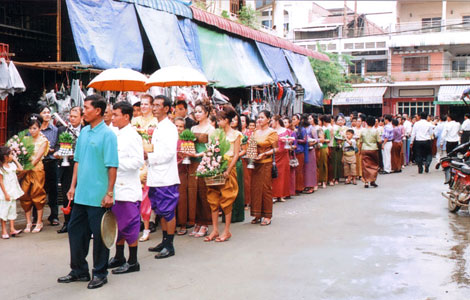
Since my family is of Cambodian heritage, we plan on having a Cambodian ceremony the morning before our wedding. Here is an overview of what a Cambodian wedding entails (we will be doing some, not all of the traditions due to time):
"Cambodian weddings
are long and intricate affairs that consist of multiple ceremonies and songs. Below are examples of programs used at two different Khmer weddings to help explain to guests some of the customs and meanings behind the various activities and performances that take place. Although regional and personal differences in wedding rituals do exist, both these programs detail the key elements of traditional Khmer weddings.
Origins of the Khmer Wedding
Khmer weddings symbolize the beautiful legend of the origin of Cambodia and parallels the marriage of the first Khmer prince, Preah Thong, to the naga princess, Neang Neak. The prince was a foreigner exiled from his homeland, and during his travels encountered and fell in love with the naga princess. As a marriage gift, the father of the naga princess swallowed a part of the ocean, and thus formed the land of Cambodia.
A traditional Khmer wedding is one of the most joyous occasions for a Khmer family and typically lasts from three days to an entire week. It is a grand affair, full of color and festivity, as well as steeped in tradition. Family, friends, and other members of the community come together to share in the celebration. Musicians play throughout the day on traditional instruments, and the couple is dressed like royalty. The bride may change her outfit several times in one day. If the wedding were a weeklong affair, she could declare the color of her dress each day and the guests would dress only in that color.
Unlike most Western weddings, guests are usually highly animated during the ceremonies, with elders typically explaining the significance of the various customs to the younger generation. Please feel free to turn to a neighbor if you should have questions or comments about what is occurring. You may also stand up and leave the room if you need to stretch your legs. Guests freely move in and out during ceremonies, which is not considered rude.
Cambodian weddings traditionally consist of ceremonies and celebrations lasting three days and three nights. Three is considered to be an especially auspicious number by Cambodians because of its association with the "three jewels" of Buddhism: the Buddha, the Sangha (brotherhood of monks), and the Dhamma (the Buddha's teachings). Due to the demands of modern day life however, today, both in Cambodia and overseas, all the following wedding ceremonies are usually completed in just one day.
Presentation of Dowry
Cambodian weddings begin with the groom and his family traveling to the bride's home bearing gifts to the bride's family as dowry. In most of today's weddings ceremonies however, all guests invited to the morning celebration will participate in this travel. This usually happens in the early morning hours (circa 7am) in order to benefit from the coolness of the day and also allow compatibility with working hours.
The groom will await before the door the arrival of the bride. The bride welcomes the groom with flowers and other gifts.
Family members and friends are introduced, and wedding rings exchanged.
Hair Cutting Ceremony
To prepare the bride and groom for their life as a married couple, their hair is symbolically cut, representing a fresh start to their new relationship together as husband and wife. The master of ceremony performs the first symbolic hair cut and wishes the couple happiness, prosperity, and longevity. The bride and groom's parents, relatives, and friends then take turn to symbolically cut the bride and groom's hair and give them blessings and well-wishes. (In the old days, the bride and groom's hair were really cut during this ceremony, but in modern times it is only done symbolically.) Two songs accompany this ceremony:
Sarika Keiv Vong (The Beautiful Cardinal Bird) · The bride's beauty is extolled and compared to that of the beautiful cardinal bird.
Trapeang Peiy (The Village Pond) · This song describes a pond with clear water where the bride was brought to take her bath. It also symbolizes the bride and groom working together in beginning their new life as wife and husband.
Pairing Ceremony
In this final and most memorable stage of the wedding, family members and friends tie the bride and groom's left and right wrists with blessing strings. The praises and well-wishes of happiness, good health, success, prosperity, and long-lasting love are acknowledged and witnessed by the loud sound of the gong and joyful cheer. The ceremony concludes with a shower of palm flowers thrown over the new couple. Four songs accompany this ceremony:
Phat Cheay · A melody inviting the bride, accompanied by her bridesmaids, to the pairing ceremony. A distinguished female relative leads the bride into the room.
Kang Saeuy · A melody accompanying the offering of gifts to the ancestor spirits and asking for their blessings.
Bangvel Po Pil (Seven Rotations) · Only married couples are permitted to sit around the bride and groom as the sacred flame is rotated seven times around the new couple. The flame of the pure bee-wax candle represents anger, which the couple should avoid as it can disrupt the marriage relationship. The smoke of the flame, however, is sacred enough to protect them from all evils if they are sincerely committed to each other. Family members who receive the candle motion their hands over the flame to guide the smoke of the sacred flame over the bride and groom.
Bay Khon Chang Dai (Tying the Wrists) · While the bride and groom's wrists are tied with the blessing strings, the following song is sung: "We tie, we tie three strings to each wrist of our children. We wish for true happiness and success to this couple, who will always be together like wet grass seeds. We tie your left wrist to make you remember your parents. We tie your right wrist to make you carry on the family lineage and traditions."
Bongvul Pbopul - Passing of Blessings
"Mun ouy laing leah, mun ouy prort preah."
"Do not separate, do not part ways."
In this ceremony, currently married couples are asked to gather in a circle around the bride and groom. Three candles are lit and handed from person to person. Each participant passes his or her right hand over it in a sweeping motion towards the couple, sending or throwing a silent blessing to them. Only married couples are asked to participate, as it is believed that they will pass along the special quality or essence which has preserved their union. The candles are passed around the circle clockwise seven times to complete the ceremony.
Sompeas Ptem - Knot Tying Ceremony
Khmer weddings traditionally have a knot tying ceremony, but unlike what the name implies, it is the guests who tie the knots, not the bride and groom. Close family and friends are invited to come forward to bring their best wishes and blessings to the new couple by individually tying ribbons around each of their wrists. These knots are tied on both the bride and groom, who were traditionally required to wear them for three days afterwards to preserve the good luck. This ceremony has customarily been considered an ideal opportunity to take a picture of each guest in attendance with the new couple." (Taken from http://www.cambodia-wedding.com/)
 |  |
 |  |